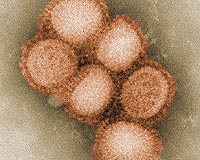| . |  |
. |
Washington (UPI) Feb 1, 2009 The U.S. Food and Drug Administration says a rare but serious liver disorder has been reported in some HIV patients taking Videx/Videx EC. The FDA said Videx (didanosine) is an antiretroviral medicine first approved in 1991, while Videx EC is a delayed-release version of Videx. Videx/Videx EC is used in combination with other antiretroviral medicines to treat human immunodeficiency virus infection in children and adults. FDA officials said 42 cases of non-cirrhotic portal hypertension were reported during an 18-year period among patients taking Videx/Videx EC. Four patients died from bleeding or liver failure after developing the condition. "Non-cirrhotic portal hypertension occurs when blood flow in the portal vein -- a major vein in the liver -- slows down and leads to severely enlarged veins in the esophagus," the FDA said. "These enlarged veins, called esophageal varices, are thin and can break open, resulting in serious, and potentially fatal, bleeding." Officials said the Videx and Videx EC product labels have been revised to help ensure health care professionals and patients are aware of the risk and the signs and symptoms of non-cirrhotic portal hypertension. The FDA evaluation concluded the clinical benefits of Videx/Videx EC in certain patients with HIV continue to outweigh potential safety risks. Videx/Videx EC is marketed by Bristol-Myers Squibb of Princeton, N.J.
Share This Article With Planet Earth
Related Links Epidemics on Earth - Bird Flu, HIV/AIDS, Ebola
 Global swine flu death toll rises to 14,711: WHO
Global swine flu death toll rises to 14,711: WHOGeneva (AFP) Jan 29, 2010 The death toll from the swine flu pandemic has risen to at least 14,711, up 569 from a week ago, the World Health Organisation (WHO) said Friday. WHO said the spread of the A(H1N1) virus peaked in most of the northern hemisphere in October and November, but transmission was still active in parts of North Africa, eastern and southeastern Europe and south and east Asia. "As of 24 January 2 ... read more |
|
| The content herein, unless otherwise known to be public domain, are Copyright 1995-2010 - SpaceDaily. AFP and UPI Wire Stories are copyright Agence France-Presse and United Press International. ESA Portal Reports are copyright European Space Agency. All NASA sourced material is public domain. Additional copyrights may apply in whole or part to other bona fide parties. Advertising does not imply endorsement,agreement or approval of any opinions, statements or information provided by SpaceDaily on any Web page published or hosted by SpaceDaily. Privacy Statement |